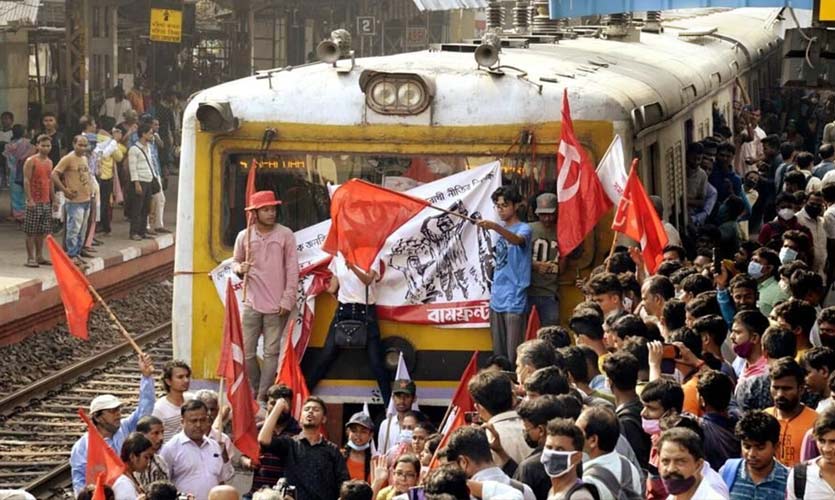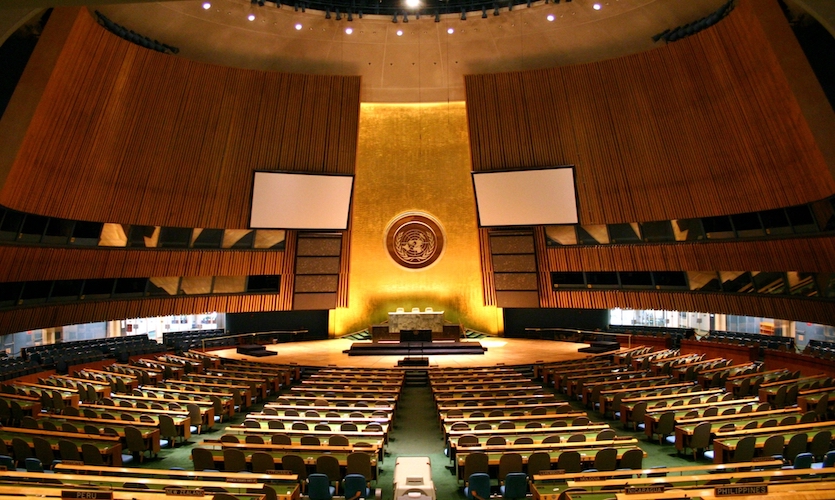The two-day nationwide strike by central trade unions against the government’s alleged problematic policies affecting workers and farmers began on Monday, March 28. ‘Save People, Save Nation’ is the slogan under which the strike is being conducted, and massive participation from workers across classes was witnessed on both days.
Well-known central trade unions including the Indian National Trade Union Congress, All India Trade Union Congress (AITUC), Hind Mazdoor Sabha, Centre of Indian Trade Unions (CITU), All India United Trade Union Centre, Trade Union Coordination Centre, Self-Employed Women’s Association, All India Central Council of Trade Unions, Labour Progressive Federation, and United Trade Union Congress have collaborated, forming a joint forum to oppose the government policies. Most of the major employee unions across the country are actively participating in the protest. The joint forum has demanded the scrapping of the labour codes and the National Monetisation Pipeline (NMP). An increase in the allocation of wages under MGNREGA, and regularisation of contract workers, are few of their other demands.
Responding to the call for strike on March 28 and 29, the Ministry of Power had issued an advisory for states on Sunday, asking them to be on high alert.
What Are They Demanding?
The pandemic has further exacerbated the plight of workers which had already been on a decline. According to a survey by the International Labour Organisation (ILO), there was a decline of 22.6 percent in the wages of migrant workers, post lockdown. 35 percent workers reportedly went without a meal for an entire day. From workplace conditions to government policies, everything seems to have contributed to them coming out on the streets to fight for their rights.
Here are some major demands of the central trade union’s joint forum:
Scrapping of the Labour Codes
The labour codes replacing the 29 labour laws were introduced to improve and facilitate the business environment in India, boosting the FDI inflow.
Code on Wages
It applies to employees in both the organised and unorganised sectors, and will ensure the timely payment of wages. The concept of floor wage, which is fixed by the government, is introduced through this code. The floor wage is determined in accordance with the minimum living standards of the area the employee is residing. Prohibition of wage discrimination between males and females is also envisaged under this code.
Trade union leaders, on the other hand, have alleged that hardly any worker in industrial towns receives a minimum wage. The Delhi government, for instance, introduced an amendment protecting the minimum wage right of the workers in 2018. But only a few receive it.
Industrial Relations Code
After considering the existing laws, a new definition was given to labour under this code. It put forward an essential categorisation of workers: skilled, unskilled, technical, manual, operational, and clerical. Additionally, a new provision of fixed-term employment in which an employer can hire on a contractual basis, and the worker will enjoy benefits similar to that of a permanent employee was introduced.
Code on Social Security and Occupational Safety
Schemes like the EPF, EPS, ESI, and many other social security benefits for the workers are provided by the Centre. Despite this, the workers complained that the existence of such policies is only on ‘paper’ and that there’s no system in place for proper implementation.
Health and Working Conditions Code
The code ensures that employers take measures to improve working conditions. The environment must be hazard-free, safe, and should not endanger the health of an employee. Certain classes of employees will also be provided annual health examinations free of cost.
The working class seems dissatisfied after these codes were introduced. They supposedly believe that it is anti-working class, and has pushed India back to the British Raj era, when workers were treated as slaves. They believe that the labour codes are pro-employers and take away some important aspects of their rights. Provisions under these codes have received severe criticism from the working class.
Scrapping of the National Monetisation Pipeline (NMP)
The NMP was introduced in 2021 in an effort to explore innovative ways of private participation in brownfield projects without transferring government ownership, which is also a matter of concern for the joint forum. Privatisation, they believe, will affect the wage structure and the rights of the workers because of the ‘hungry for profit’ nature of multinational corporations.
Regularisation of contract workers
Currently, under the Contract Labour (Regulation & Abolition) Act, 1970, there is no proposal to regularise contract workers, because of which, the government is hiring contract workers on lesser wages. The unions argue that through this concept the government is swiftly escaping the minimum wage provision, and is blatantly exploiting the working class.
Increase in MGNREGA budget
Compensation under the Mahatma Gandhi National Rural Employment Guarantee Act (MGNREGA), 2005, has been reduced by 25 percent this year, amid high rural unemployment. In a way, this scheme is a lifeline for almost 11 crore workers, therefore, slashes like this come with severe ramifications on the working class. Protesting employees in UP, for instance, were quite clear about their demand to increase the MGNREGA budget, along with a declaration of 200 days of work with Rs 500 as a daily wage. Looking at the state of unemployment in urban areas, the need for similar schemes is on the rise.
Social Security
Statistically speaking, a major proportion of India’s working class is dependent on some form of social security, healthcare services, unemployment allowances, pension, among others. Moreover, there are over 60 lakh workers also known as ‘scheme workers’ or ‘Anganwadi workers’. This workforce primarily comprises women, provides health and child care services, and has worked at the forefront during the pandemic. They demand regularisation and want to be treated as workers with rights, not just volunteers.
Read more: Why Does Political Candidacy Continue To Be A Challenge For Women In India?
Consequences Of The Strike
Reportedly, the entire coal belt of Chhattisgarh, Jharkhand, and Madhya Pradesh has been affected due to the strike. The AITUC general secretary said that the banking and insurance sectors have been impacted all over India, while the steel and oil sectors have also witnessed a minute disruption. All the major industrial areas in most of the states, including Delhi, remained closed as work at all the manufacturing units came to a halt.
Hundreds of thousands of workers from transport, electricity, railways, banking, insurance, coal, steel, oil, and many more fields have come forward. More than 70 percent of tea, coffee, and rubber plantation workers in Tamil Nadu, along with auto-rickshaw drivers, joined the strike.
Tapan Sen, general secretary of the CITU said,” This historic strike call was given not merely on the immediate demands of the workers but against the anti-national destructive policies of the central government.” He thanked all the workers and employees for joining the strike on the first day. “The laws for which workers fought for years are now being diluted to benefit the employers,” said a group leader in Delhi.
This two-day nationwide agitation has posed an interesting challenge in front of the ruling BJP-government. Is keeping close ties with private players as important as being on good terms with the working class of the country?










